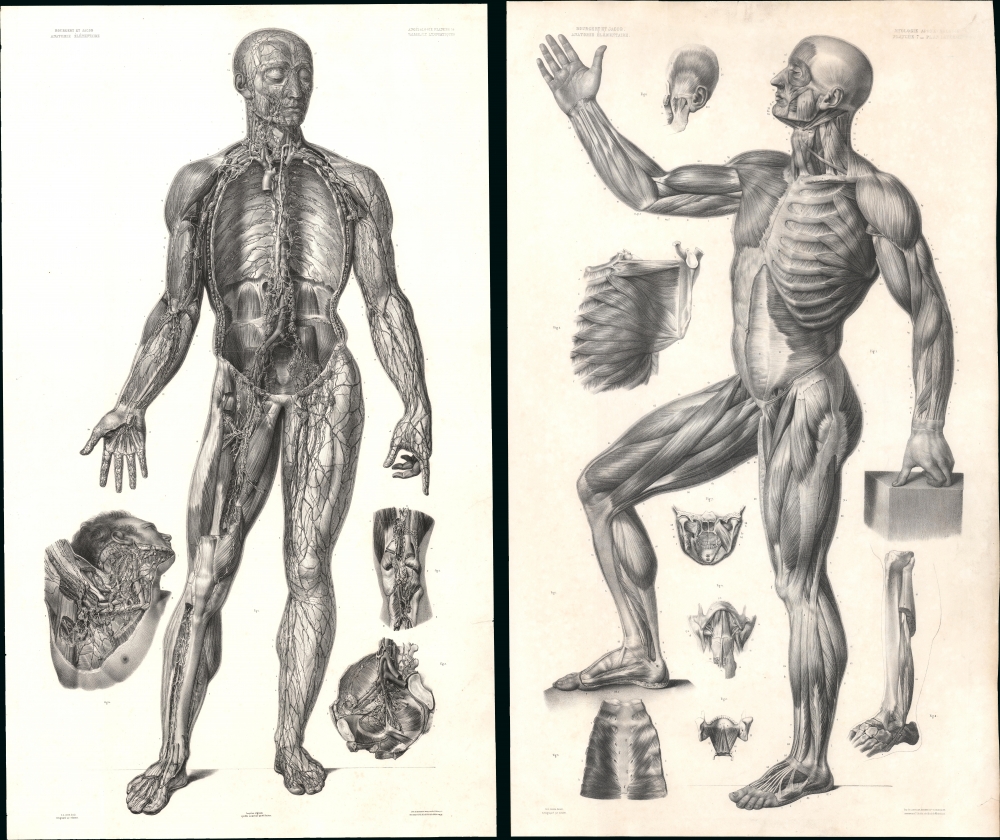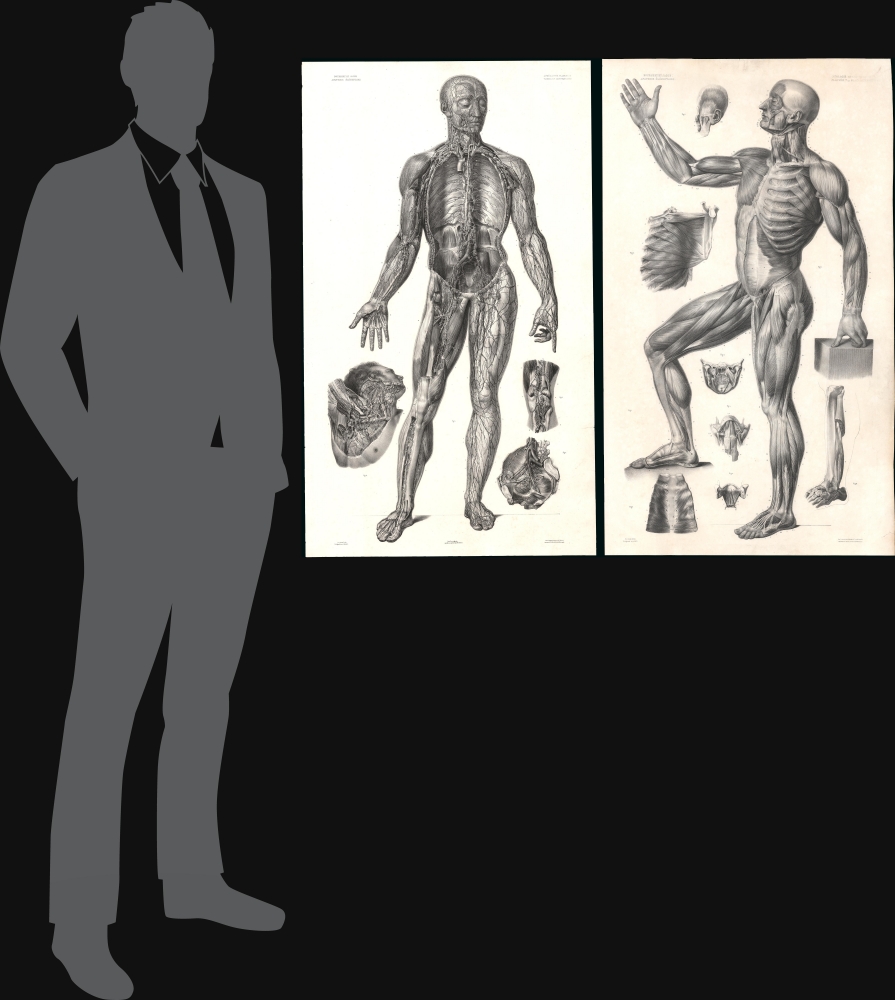1839 Bourgery / Jacob Anatomical Studies of the Lymphatic and Muscular Systems
Anatomie-bourgery-1839
Title
1839 (undated) 35 x 20.5 in (88.9 x 52.07 cm)
Description
Vaisseaux Lymphatiques
Perhaps the more eye-catching of the two sheets is the left, representing the lymphatic system. To produce this detailed study, a cadaver was injected with mercury. This technique highlighted even the smallest vessels, making them clear to the naked eye as vibrant silver traceries. In this case, the anatomical study was conducted by a 'Mr. Jonbert', who we have unfortunately been unable to identify.Myologie Aponévrologie
The right-hand sheet offers a more traditional illustration of the muscular system from a profile view. It illustrates the complex layering of muscles in the male chest, arms, inner and outer thighs, feet, and head. The figure strikes a heroic, almost Shakspearian pose.In the 1845 L'Univers. France Dictionnaire encyclopédique, volume 3, Bourgery's anatomical work is praised,It is enough for us to say here that the work of Mr. Bourgery is one of the most beautiful of which our century will boast. To all the facts that the most in-depth historical knowledge could reveal to him, the author adds discoveries of his own; and he had the talent to bring the attention of anatomists back to particularities glimpsed by ancient authors, but forgotten, or even rejected, by observers less attentive than himself.
Qu'il nous suffise de dire ici que l'ouvrage de M. Bourgery est un des plus beaux dont se glorifiera notre siècle. À tous les faits que pouvaient lui révéler les connaissances historiques les plus approfondies, l'auteur y joint des découvertes qui lui sont propres; et il a eu le talent de ramener l'attention des anatomistes sur des particularités entrevues par d'anciens auteurs, mais oubliées, ou même rejetées, par des observateurs moins attentifs que lui.
Publication History and Census
These studies were prepared for Jean-Marc Bourgery and Nicolas-Henri Jacob, c. 1839, for Anatomie élémentaire en 20 planches, an abridged 20-sheet large-plate issue of Bourgery and Jacob's 725 plate magnum opus Traité de l'anatomie de l'homme. Both images here were drawn by Jacob in collaboration with Bourgery. The left sheet (14), was set to lithographic stone by Pérassin and published by Bernard et Frey and Crochard et Cie. The right sheet (7) was set to stone by Aumont, and published by Lemercier, Benard et Cie. And Crochart et Cie. Rare. We note a complete 1839 set of 20 sheets at the Université Paris Cité, Harvard Medical School, and Service de santé des Armées. Paris Cité also holds a c. 1853 color variant published c. 1853. No market history, although from time to time other plates from the series do come to the market.CartographerS
Jean-Marc Bourgery's (May 19, 1797 - June, 1849) was a French physician and anatomist. Bourgery was born in Orléans. He entered the École de Médecine de Paris in 1811 and in 1815 became an internist at the Hôtel-Dieu de Paris. In 1817 et 1818, his anatomic work received prices at the École pratique de la faculté de médecine de Paris, and in 1819 was awarded the gold medal of the hospital of Paris. He began teaching medicin at Laennec and was a health officer at a copper foundry near Rouen. Returning to Paris in 1827, he studied for an additional three years, receiving his doctorate in record time. His thesis on circular ligatures became a seminal work, republished multiple times in English, German, and even Arabic. He began his magnum opus, Traité complet de l'anatomie de l'homme (1829 - 1854), a groundbreaking study of human anatomy featuring 725 large-scale anatomical plates by collaborating artist Nicholas-Henri Jacob (1782 - 1871). This monumental work, was praised in its time by the by the Society of Fine Arts of Paris, as 'magnificent,' and 'a beautiful book … unique in [its] genre' and 'of great truth of detail [and] a masterpiece of execution for accuracy. Bourgery died of cholera in Passy in June 1849, while still adding to on his masterpiece. Despite the significance of his work Bourgery never received the official recognition for his achievements. More by this mapmaker...
Nicolas-Henri Jacob (June 6, 1782 - January 31, 1871) was a French painter, designer, furniture maker, and scientific lithographer active in the mid 19th century. Jacob was born in Paris, the sone of a carpenter and grandson, through is mother Antoinette-Charlotte Prudhomme, grandson of master painter Nicolas Prudhomme. He studied painting Jacques-Louis David (1748 - 1825), Antoine Dupasquier (1748 - 1831). and Jean-Jacques Morgan (1756 - 1799), and cabinetmaking under Georges Jacob (1739 - 1814). He first presented at the Paris Salon in 1802, his performance at which earned him the patronage of Eugene Rose de Beauharnais, adopted son of Napoleon Bonaparte. In addition to his painting, he designed furniture for the famous store, L'Escalier de Cristal, of Marie Desarnaud (1775 - 1842), where he designed the extraordinary crystal dressing table of the Duchess of Berry (Louvre Museum). From 1818 to 1830, he worked as a drawing teacher at the National Veterinary School of Alfort. It was perhaps here that he developed an interest in both anatomy and the emerging lithographic technique. Jacob devoted himself very early to lithography, of which he was one of the pioneers. His first plates were exhibited at the Paris Salon of 1819, then became recurrent from the Salon of 1824 (portraits, genre scenes, etc.). He turned his attention to scientific and medical publishing from 1830 to 1850, dedicating himself to the execution of 725 lithograph plates for Jean-Marc Bourgery's (1797 - 1849) monumental Traité complet de l'anatomie de l'homme (1829 - 1854). At this point in his career, although he continued to teach drawing, he stopped exhibiting, turning himself fully to science. The Bourgery-Jacob anatomical plates were a landmark in scientific illustration. Jacob died in his Paris home at 25, Rue du Chemin des Plantes. Learn More...
Rose-Joseph Lemercier (June 29, 1803 - 1887) was a French photographer, lithographer, and printer. One of the most important Parisian lithographers of the 19th century, Lemercier was born in Paris into a family of seventeen children. His father was a basket maker, and he even began working as a basket maker at the age of fifteen, but Lemercier was drawn to lithography and printing and soon entered into an apprenticeship with Langlumé, where he worked from 1822 until 1825. After working for a handful of other printers, Lemercier started his own firm in 1828 at 2, rue Pierre Sarrazin with only one printing press. He subsequently moved a few more times before arriving at 57, rue de Seine, where he founded the printing firm Lemercier and Company. He created the firm Lemercier, Bénard and Company in 1837 with Jean François Bénard. Lemercier bought out Bénard's share in the firm in 1843 and, since his two sons died at a young age, he decided to bring his nephew Alfred into the business beginning in 1862, who would progressively take on more and more responsibility in running the firm. Between 1850 and 1870, Lemercier's firm was the largest lithographic company in Paris. The firm began to decline in prestige in the early 1870s, and, after Lemercier's death in 1887, its descent only quickened. It is unclear when the firm closed, but Alfred directed the firm until his death in 1901. Learn More...
Nicolas Crochard (May 11, 1772 - May 18, 1839) was a French bookseller and publisher active in Paris. He was born in Vic-sur-Seille (Moselle). Crochard et Cie. was founded in 1802 in associate with Pierre-Antoine-Louis Allut. In 1804, Crochard bought out Allut, continuing the business on his own account. From 1807, he specialized in scientific and medical publishing. Crochard was patented bookseller on October 1, 1812 (renewed on September 11, 1818). From 1821, his son Eugène Crochard (1801 - 1876), mentioned by the Annuaire de l'impressionie, ran the firm under the name 'Crochard Fils', though the father remained active in the business. Eugène's formally took ownership in 1827, taking Victor Masson (1807 - 1879) as a partner in 1835. The ownership of the firm was passed to Masson's son, Georges Masson (1839 - 1900), who in 1900 passed the firm to Pierre-Victor Masson (1865 - 1928). In the 1930s, Georges Masson (1900 - 1973) ran the company. Over the years the firm's name changed to Victor Masson et Fils and then in 1896 to Librairie Masson et Compagnie (Masson et Cie). In 1987, Masson purchased Armand Colin. In turn, it became part of the City Group (Groupe de la Cité) in 1994. In 2000, Groupe de la Cité became part of Vivendi Universal Publishing (VUP). It remains active. Learn More...




